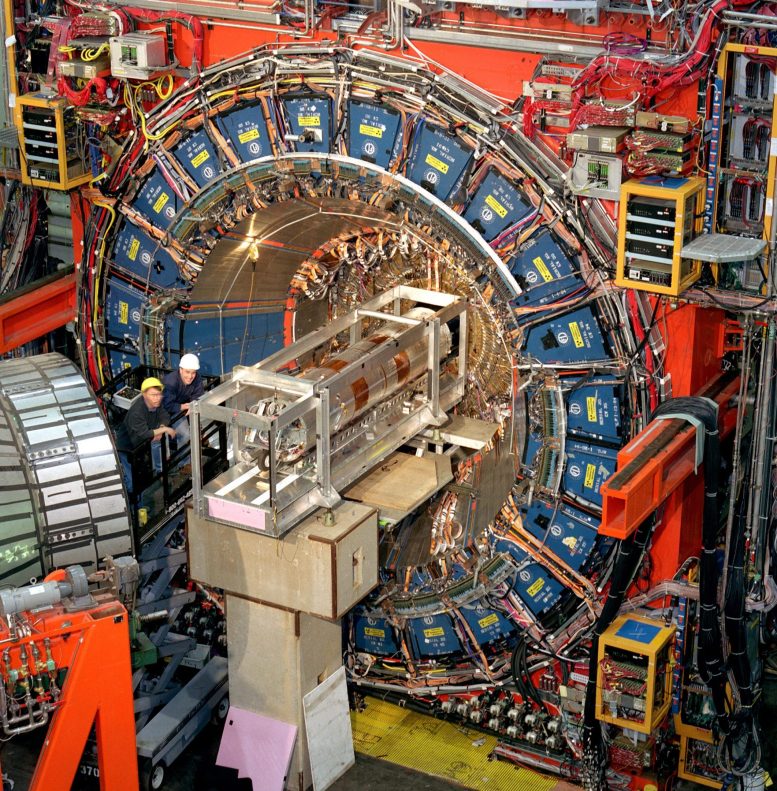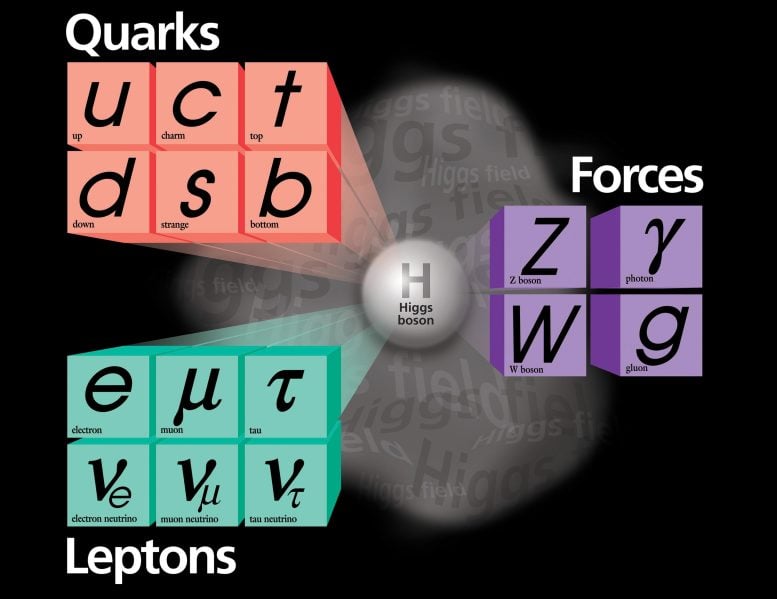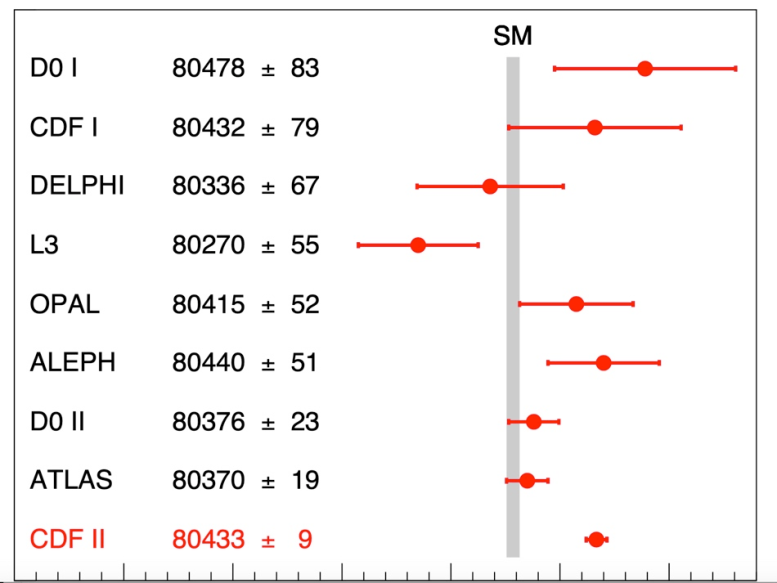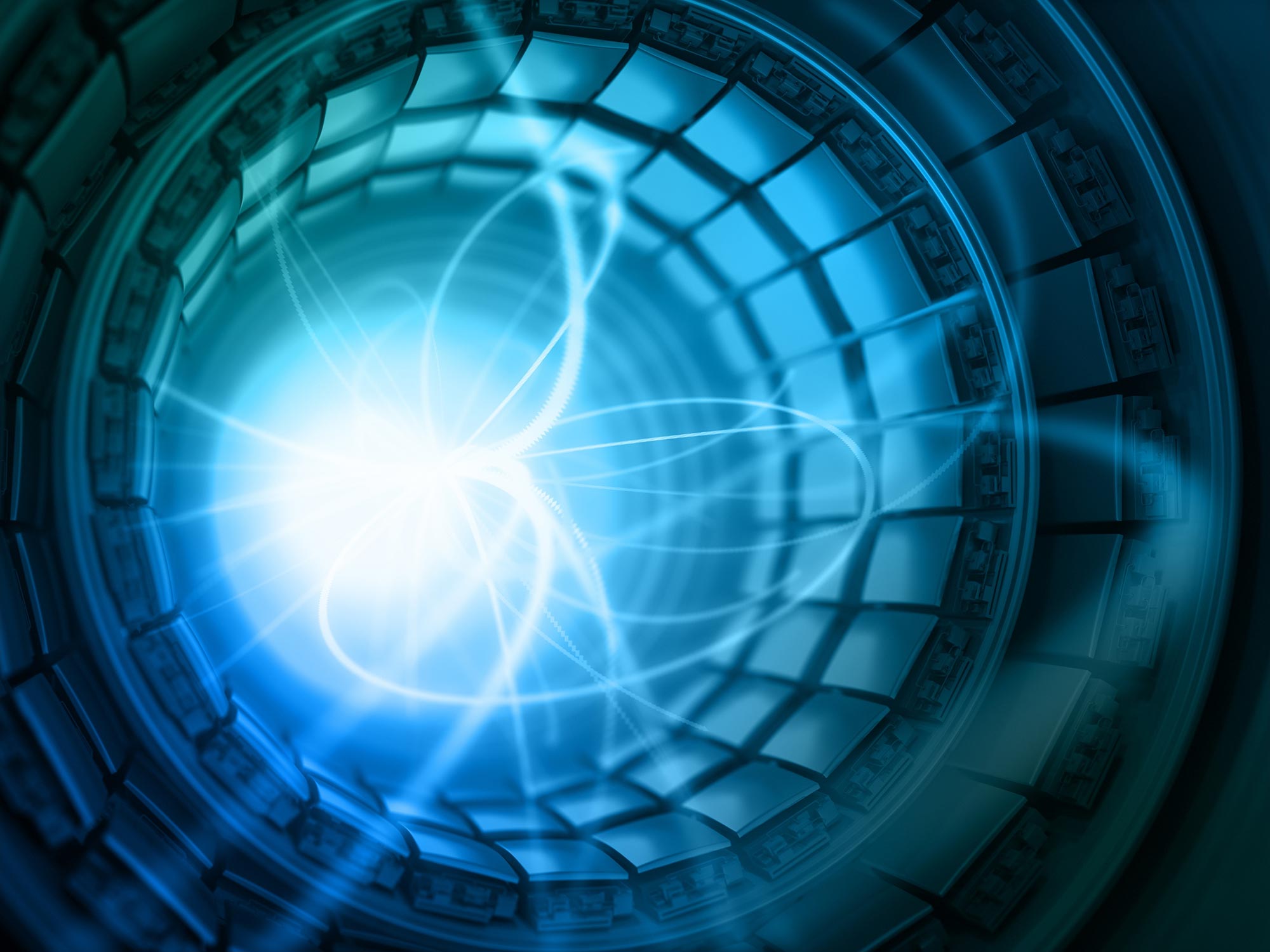Vůbec nejpřesnější měření hmotnosti bosonu W ukazuje napětí se standardním modelem.
Po 10 letech pečlivé analýzy a zkoumání oznámili vědci CDF z Fermi National Accelerator Laboratory amerického ministerstva energetiky 7. dubna 2022, že dosáhli dosud nejpřesnějšího měření hmotnosti bosonu W, jedné z přírodních sil- nesoucí částice. Pomocí dat shromážděných Fermilabovým Collider Detector, neboli CDF, vědci nyní určili hmotnost částice s přesností 0,01 % – což je dvojnásobek přesnosti předchozího nejlepšího měření. Odpovídá gorilě o hmotnosti 800 liber až 1,5 unce.
Nová přesná váha zveřejněná v časopise vědět, umožňuje vědcům testovat Standardní model částicové fyziky, teoretický rámec, který popisuje přírodu na její nejzákladnější úrovni. Výsledek: Nová hodnota hmotnosti ukazuje napětí s hodnotou, kterou vědci získají pomocí experimentálních a teoretických vstupů v kontextu standardního modelu.

Detektor urychlovače Fermilab zaznamenal srážky vysokoenergetických částic generované urychlovačem Tevatron v letech 1985 až 2011. Asi 400 vědců z 54 institucí ve 23 zemích stále pracuje na množství dat shromážděných experimentem. Kredit: Fermilab
„Počet vylepšení a dodatečného ověření našich výsledků je enormní,“ řekl Ashutosh V. Kotwal z Duke University, který vedl tuto analýzu a je jedním ze 400 vědců spolupracujících na CDF. „Vzali jsme v úvahu naše lepší porozumění našemu detektoru částic a také pokroky v teoretickém a experimentálním chápání interakcí bosonu W s jinými částicemi. Když jsme konečně odhalili výsledek, zjistili jsme, že se liší od předpovědi standardního modelu.“ „
Pokud se toto měření potvrdí, naznačuje potenciální potřebu vylepšení na úkor standardního modelu nebo rozšíření modelu.
Vědci nyní určili hmotnost W bosonu s přesností 0,01 %. To je dvojnásobná přesnost oproti předchozímu nejlepšímu měření a ukazuje napětí se standardním modelem.
Nová hodnota je v souladu s mnoha předchozími měřeními hmotnosti bosonu W, ale existují také určité rozdíly. Budoucí měření budou potřeba, aby výsledek vnesla více světla.
„I když jde o zajímavý výsledek, měření musí být potvrzeno dalším experimentem, než bude možné plně vysvětlit,“ řekl zástupce ředitele Fermilabu Joe Lykken.
W boson je poslem částice slabé jaderné síly. Je zodpovědný za jaderné procesy, které způsobují, že slunce svítí a molekuly se rozpadají. Pomocí srážek částic s vysokou energií z urychlovače Tevatron ve Fermilabu shromáždila spolupráce CDF obrovské množství dat obsahujících bosony W od roku 1985 do roku 2011.

W boson je poslem částice slabé jaderné síly. Je zodpovědný za jaderné procesy, které způsobují, že slunce svítí a molekuly se rozpadají. Vědci z CDF studují vlastnosti bosonu W pomocí dat, která shromáždili na urychlovači Tevatron ve Fermilabu. Kredit: Fermi National Accelerator Laboratory
CDF fyzik Chris Hayes z[{“ attribute=““>University of Oxford said, “The CDF measurement was performed over the course of many years, with the measured value hidden from the analyzers until the procedures were fully scrutinized. When we uncovered the value, it was a surprise.”
The mass of a W boson is about 80 times the mass of a proton, or approximately 80,000 MeV/c2. CDF researchers have worked on achieving increasingly more precise measurements of the W boson mass for more than 20 years. The central value and uncertainty of their latest mass measurement is 80,433 +/- 9 MeV/c2. This result uses the entire dataset collected from the Tevatron collider at Fermilab. It is based on the observation of 4.2 million W boson candidates, about four times the number used in the analysis the collaboration published in 2012.

The mass of a W boson is about 80 times the mass of a proton, or approximately 80,000 MeV/c2. Scientists of the Collider Detector at Fermilab collaboration have achieved the world’s most precise measurement. The CDF value has a precision of 0.01 percent and is in agreement with many W boson mass measurements. It shows tension with the value expected based on the Standard Model of particle physics. The horizontal bars indicate the uncertainty of the measurements achieved by various experiments. The LHCb result was published after this paper was submitted and is 80354+- 32 MeV/c2. Credit: CDF collaboration
“Many collider experiments have produced measurements of the W boson mass over the last 40 years,” said CDF co-spokesperson Giorgio Chiarelli, Italian National Institute for Nuclear Physics (INFN-Pisa). “These are challenging, complicated measurements, and they have achieved ever more precision. It took us many years to go through all the details and the needed checks. It is our most robust measurement to date, and the discrepancy between the measured and expected values persists.”
The collaboration also compared their result to the best value expected for the W boson mass using the Standard Model, which is 80,357 ± 6 MeV/c2. This value is based on complex Standard Model calculations that intricately link the mass of the W boson to the measurements of the masses of two other particles: the top quark, discovered at the Tevatron collider at Fermilab in 1995, and the Higgs boson, discovered at the Large Hadron Collider at CERN in 2012.
CDF co-spokesperson David Toback, Texas A&M University, stated the result is an important contribution to testing the accuracy of the Standard Model. “It’s now up to the theoretical physics community and other experiments to follow up on this and shed light on this mystery,” he added. “If the difference between the experimental and expected value is due to some kind of new particle or subatomic interaction, which is one of the possibilities, there’s a good chance it’s something that could be discovered in future experiments.”
Reference: “High-precision measurement of the W boson mass with the CDF II detector” by CDF Collaboration, T. Aaltonen, S. Amerio, D. Amidei, A. Anastassov, A. Annovi, J. Antos, G. Apollinari, J. A. Appel, T. Arisawa, A. Artikov, J. Asaadi, W. Ashmanskas, B. Auerbach, A. Aurisano, F. Azfar, W. Badgett, T. Bae, A. Barbaro-Galtieri, V. E. Barnes, B. A. Barnett, P. Barria, P. Bartos, M. Bauce, F. Bedeschi, S. Behari, G. Bellettini, J. Bellinger, D. Benjamin, A. Beretvas, A. Bhatti, K. R. Bland, B. Blumenfeld, A. Bocci, A. Bodek, D. Bortoletto, J. Boudreau, A. Boveia, L. Brigliadori, C. Bromberg, E. Brucken, J. Budagov, H. S. Budd, K. Burkett, G. Busetto, P. Bussey, P. Butti, A. Buzatu, A. Calamba, S. Camarda, M. Campanelli, B. Carls, D. Carlsmith, R. Carosi, S. Carrillo, B. Casal, M. Casarsa, A. Castro, P. Catastini, D. Cauz, V. Cavaliere, A. Cerri, L. Cerrito, Y. C. Chen, M. Chertok, G. Chiarelli, G. Chlachidze, K. Cho, D. Chokheli, A. Clark, C. Clarke, M. E. Convery, J. Conway, M. Corbo, M. Cordelli, C. A. Cox, D. J. Cox, M. Cremonesi, D. Cruz, J. Cuevas, R. Culbertson, N. d’Ascenzo, M. Datta, P. de Barbaro, L. Demortier, M. Deninno, M. D’Errico, F. Devoto, A. Di Canto, B. Di Ruzza, J. R. Dittmann, S. Donati, M. D’Onofrio, M. Dorigo, A. Driutti, K. Ebina, R. Edgar, A. Elagin, R. Erbacher, S. Errede, B. Esham, S. Farrington, J. P. Fernández Ramos, R. Field, G. Flanagan, R. Forrest, M. Franklin, J. C. Freeman, H. Frisch, Y. Funakoshi, C. Galloni, A. F. Garfinkel, P. Garosi, H. Gerberich, E. Gerchtein, S. Giagu, V. Giakoumopoulou, K. Gibson, C. M. Ginsburg, N. Giokaris, P. Giromini, V. Glagolev, D. Glenzinski, M. Gold, D. Goldin, A. Golossanov, G. Gomez, G. Gomez-Ceballos, M. Goncharov, O. González López, I. Gorelov, A. T. Goshaw, K. Goulianos, E. Gramellini, C. Grosso-Pilcher, J. Guimaraes da Costa, S. R. Hahn, J. Y. Han, F. Happacher, K. Hara, M. Hare, R. F. Harr, T. Harrington-Taber, K. Hatakeyama, C. Hays, J. Heinrich, M. Herndon, A. Hocker, Z. Hong, W. Hopkins, S. Hou, R. E. Hughes, U. Husemann, M. Hussein, J. Huston, G. Introzzi, M. Iori, A. Ivanov, E. James, D. Jang, B. Jayatilaka, E. J. Jeon, S. Jindariani, M. Jones … P. Wagner, R. Wallny, S. M. Wang, D. Waters, W. C. Wester, D. Whiteson, A. B. Wicklund, S. Wilbur, H. H. Williams, J. S. Wilson, P. Wilson, B. L. Winer, P. Wittich, S. Wolbers, H. Wolfmeister, T. Wright, X. Wu, Z. Wu, K. Yamamoto, D. Yamato, T. Yang, U. K. Yang, Y. C. Yang, W.-M. Yao, G. P. Yeh, K. Yi, J. Yoh, K. Yorita, T. Yoshida, G. B. Yu, I. Yu, A. M. Zanetti, Y. Zeng, C. Zhou and S. Zucchelli, 7 April 2022, Science.
DOI: 10.1126/science.abk1781
The CDF collaboration comprises 400 scientists at 54 institutions in 23 countries.

„Unapologetický analytik. Rozzuřeně skromný kávový evangelista. Hráč. Nelze psát s boxerskými rukavicemi. Student. Podnikatel.“
You may also like
-
Detekce částí viru ptačí chřipky v mléce
-
Umělá inteligence spojuje metabolity střevních bakterií s rozvojem Alzheimerovy choroby
-
Vysokorychlostní zobrazování a umělá inteligence nám pomáhají pochopit, jak fungují hmyzí křídla
-
Jak může život přežít na přílivově uzamčených planetách?
-
Pluto získalo „flip“ po srážce s planetárním tělesem

